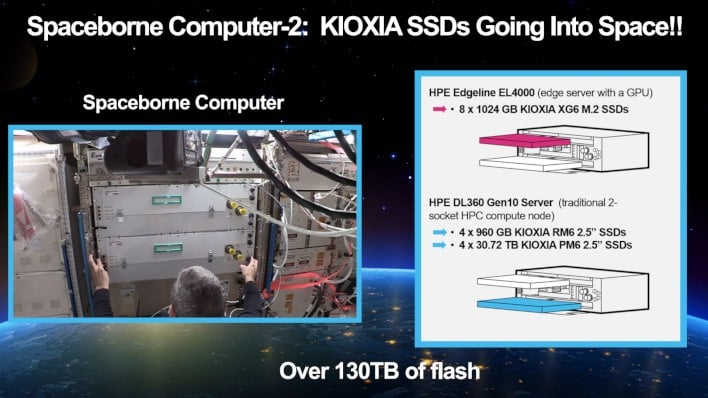Kioxia SSDs Liftoff To The ISS For Critical Space Server Storage Demands
Kioxia is one of those names that you might not see a lot if you're primarily a DIY PC gamer. Whether you realize it or not, the original inventor of flash memory (when it was known as Toshiba Memory Solutions) moves a LOT of NAND. You can find Kioxia flash memory in just about any kind of device, and now, that includes the International Space Station.
Indeed, with the launch of the NG-20 mission rocket from Cape Canaveral, an updated HPE Spaceborne Computer-2 has been delivered to the International Space Station. Aboard that machine was more than 130 terabytes of Kioxia flash memory. The bulk of the storage was in the form of four enterprise SSDs connected via SAS, each a staggering 30.72 TB in capacity. That's TB, as in terabytes, as in 31,457 gigabytes, each.
The mechanisms inside conventional hard disk drives work fine in the zero-gravity environment of space, but ultimately flash is more reliable, uses less power, and is obviously much faster. As the manufacturer says, SSDs are less susceptible to EMF interference than hard drives, which rely on relatively fragile magnetic states to store data. Of course, SSDs wear out too, but that's a much smaller concern than an entire disk failing.
Historically, any data gathered by the ISS had to be beamed back to earth for processing to extract the salient data, or "insights", from the noise. Having an onboard supercomputer means that the crew on the ISS can analyze the data in real time, resulting in a 30,000x reduction in download size for surface-bound research squads. Congratulations to HPE and Kioxia on the installation of the new system.
Indeed, with the launch of the NG-20 mission rocket from Cape Canaveral, an updated HPE Spaceborne Computer-2 has been delivered to the International Space Station. Aboard that machine was more than 130 terabytes of Kioxia flash memory. The bulk of the storage was in the form of four enterprise SSDs connected via SAS, each a staggering 30.72 TB in capacity. That's TB, as in terabytes, as in 31,457 gigabytes, each.
Interestingly, not all of the hardware that went into the Spaceborne Computer-2 is actually enterprise-grade. Inside the HPE Edgeline EL4000—a GPU-equipped edge server—are eight Kioxia XG6 M.2 SSDs. Kioxia explains that the HPE Spaceborne Computer-2 is largely based on commercial off-the-shelf technology. As a result, the SSDs inside the system weren't bespoke designs from Kioxia, or anything like that—just part of the memory maker's usual catalog. Kioxia says that the ISS's new computer is designed for HPC workloads, including real-time image processing, deep learning, and scientific simulations.
Image: Kioxia
The mechanisms inside conventional hard disk drives work fine in the zero-gravity environment of space, but ultimately flash is more reliable, uses less power, and is obviously much faster. As the manufacturer says, SSDs are less susceptible to EMF interference than hard drives, which rely on relatively fragile magnetic states to store data. Of course, SSDs wear out too, but that's a much smaller concern than an entire disk failing.
Historically, any data gathered by the ISS had to be beamed back to earth for processing to extract the salient data, or "insights", from the noise. Having an onboard supercomputer means that the crew on the ISS can analyze the data in real time, resulting in a 30,000x reduction in download size for surface-bound research squads. Congratulations to HPE and Kioxia on the installation of the new system.



